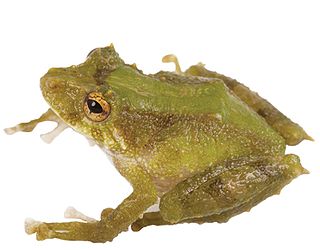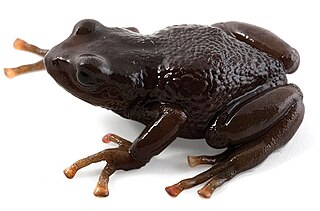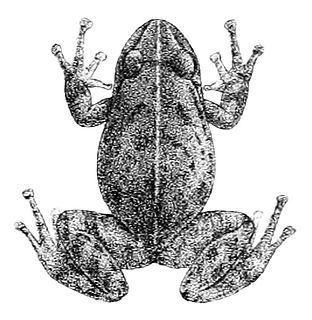
Osornophryne sumacoensis is a species of toad in the family Bufonidae. It is endemic to the Ecuador and only found in the forests surrounding a small crater lake on the eastern slopes of Sumaco, a volcano in the Napo Province.

Nymphargus anomalus is a species of frog in the family Centrolenidae. It is endemic to Ecuador and occurs on the Amazonian slopes of the Ecuadorian Andes in the Napo Province. Common name Napo Cochran frog has been coined for it.
Hyloxalus bocagei is a species of frog in the family Dendrobatidae. It is found on the northeastern side of the Andes in Ecuador and in Colombia. The specific name bocagei honors José Vicente Barbosa du Bocage, a Portuguese zoologist. Common name Bocage's rocket frog has been coined for this species.
Osteocephalus fuscifacies is a species of frog in the family Hylidae endemic to Ecuador. It is known from the Napo River drainage at intermediate elevations. The specific name fuscifacies is derived from Latin fuscus (=tan) and facies (=face), in reference to the uniform tan-colored loreal region and the lack of a light subocular spot. Common name Napo slender-legged treefrog has been coined for this species.
Pristimantis balionotus is a species of frog in the family Strabomantidae. It is endemic to Ecuador and only known from its type locality on the border between the Loja and Zamora-Chinchipe Provinces, near the crest of the Ecuadorian Andes. Common name crest robber frog has been coined for it.
Pristimantis citriogaster, also known as the throated robber frog, is a species of frog in the family Strabomantidae. It is known from northern Peru near Tarapoto and south-eastern Ecuador. Its natural habitats are premontane rainforest and cloud forest. Adults are nocturnal and typically occur on rocks in and along cascading streams. Its altitudinal range is 600–1,094 m (1,969–3,589 ft) asl.
Pristimantis cryophilius is a species of frog in the family Strabomantidae. It is endemic to the Ecuadorian Andes in the Azuay, Cañar, and Morona-Santiago Provinces. The specific name cryophilius is derived from Greek kryos for cold and philois for loving and refers to the affinity of this species for cold climate. Common name San Vicente robber frog has been coined for it.
Pristimantis gentryi is a species of frogs in the family Strabomantidae. It is endemic to central Ecuador where it is found in a small area west of the Páramo de Apagua, Cotopaxi Province. The specific name gentryi honors Alwyn Gentry, American botanist who perished during his field work in Ecuador. Common name Pilalo robber frog has been proposed for this species.

Pristimantis inusitatus is a species of frog in the family Craugastoridae. It is endemic to Ecuador and known from scattered localities along the eastern slopes of the Andes. Common name barking robber frog has been coined for it.
Pristimantis luscombei is a species of frog in the family Craugastoridae. It is known from northeastern Peru, adjacent Amazonian Ecuador, and from Acre state, Brazil. Some of the paratypes were later identified as belonging to another species, described in 2014 as Pristimantis miktos. At the same time, Pristimantis achuar was identified as synonym of Pristimantis luscombei.
Pristimantis modipeplus is a species of frog in the family Craugastoridae. It is endemic to the Andes of central Ecuador in Chimborazo, Pichincha, and Tungurahua Provinces. Common name Urbina robber frog has been proposed for it.
Pristimantis ocreatus is a species of frog in the family Craugastoridae. Although often reported as being endemic to the Andes of northern Ecuador, it has also been reported from extreme southern Colombia ; the possibility of range extension to Colombia has been acknowledged. Its type locality is the west slope of volcano Chiles in the Carchi Province, and common name Carchi robber frog has been coined for it. These frogs have pale hands and feet, as if wearing gloves and socks—hence the specific name ocreatus, which is Latin and means "wearing leggings" or "booted".

Pristimantis orcesi is a species of frog in the family Craugastoridae. It is endemic to the Andes of central and northern Ecuador. The specific name orcesi honors Gustavo Orcés, an Ecuadorian naturalist. Common names Orces robber frog and Bolivar robber frog have been proposed for this species.

Pristimantis pycnodermis is a species of frog in the family Craugastoridae. It is endemic to the Ecuadorean Andes and occurs in the Cordillera de Matanga in the Azuay and Morona-Santiago Provinces. The specific name pycnodermis is Greek and means "thick skin", a characteristic of this species. Common name thickskin robber frog has been coined for it.
Pristimantis subsigillatus is a species of frog in the family Craugastoridae. It is found in the lowlands in southwestern Colombia and western Ecuador up to elevations of 1,162 m (3,812 ft) asl. It is sometimes known as Salidero robber frog or engraved rainfrog.

Pristimantis unistrigatus is a species of frog in the family Craugastoridae. It is found in the Andean valleys from southern Colombia to central Ecuador.
Pristimantis vertebralis is a species of frog in the family Craugastoridae. It is endemic to the Andes of Ecuador and occurs in the Carchi, Imbabura, Pichincha, Cotopaxi, Bolívar, and Azuay provinces. Common name vertebral robber frog has been coined for it.

Sumaco Napo-Galeras National Park is a protected area in Ecuador situated in the Napo Province, Orellana Province and Sucumbíos Province. The highest point of the park is the Sumaco volcano that peaks at 3,732 m; the lowest altitude is 600 m.

Pristimantis acerus is a species of frog in the family Strabomantidae. It is endemic to Ecuador and known from the area of its type locality between Papallacta and Cuyujúathe in the Napo Province and from the Llanganates National Park, Pastaza Province. This species is rated as Endangered by the IUCN. Common name Papallacta robber frog has been coined for it.

Sumaco is a symmetrical, isolated stratovolcano, that is set off from the main Ecuador volcanic axis. Its rocks are very distinct from those from most Andean volcanoes because of its lack of andesitic composition, in favour of basanite and phonolitic rock. Sumaco is heavily forested and contains a small cone in its broad summit crater. An historical eruption occurred around 1895.









